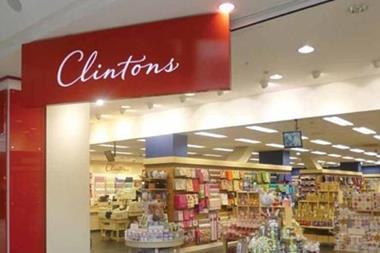As Paperchase holds a crunch meeting with creditors to secure support for its restructuring plan, Retail Week asks whether there’s trouble on the cards for the whole stationery sector.
According to the BRC KPMG Sales Monitor figures for last December, stationery in general had a poor festive period. The category was ranked as the worst-performing both in terms of like-for-like and total sales over the period.
However, some retailers – including WHSmith, Moonpig and Clintons – bucked that trend and delivered some impressive Christmas sales figures.
Only a few years ago, Paperchase was rapidly expanding. Now it faces the prospect of having to close stores, both in the UK and overseas, through a CVA and is understood to be exploring a sale, which might include a pre-pack administration. So, how did the star of the stationery sector lose its shine?
Too premium?
In terms of its core stationery sales, Zoe Mills, retail analyst at GlobalData, believes Paperchase’s reputation for premium products has allowed discount and value retailers such as Wilko and B&M to undercut it on price.
“Discounters and value retailers have really focused in the last few years on improving their designs and range. Both Wilko and B&M, for example, stock an array of stationery to target different demographics that compete with the likes of Paperchase.
“Consumers know that if they can get something similar for a lower cost they are more readily willing to trade down”
Zoe Mills, GlobalData
“Consumers are savvy and highly price-conscious and they know that if they can get something similar for a lower cost they are more readily willing to trade down.”
She also believes that Paperchase’s stationery offer has failed to follow key drivers in the market, such as “design and trend-led products” and hobbies such as “bullet journaling”, visual note-taking loved by Instragrammers and bloggers.
Overexpansion

John Stephenson, retail analyst at Peel Hunt, points to Paperchase’s rapid expansion as a reason for its current malaise.
“I think they’ve been pushing space really hard; pushing into locations that they maybe wouldn’t have opened in previously,” he says.
He believes that “spontaneous gifting” is a hugely important sales avenue for stationery retailers and those stores operating in areas with low footfall are missing out on this crucial revenue stream.
“If you looked at the performances of Paperchase stores in central London or Manchester – those places with good footfall drivers – I’d imagine they did pretty well. There’s a good level of spontaneous gifting that comes from high footfall around Christmas, even if it did come late.
“However, if you’re looking at a number of marginal sites with small levels of footfall then you’re not going to be picking up that spontaneous shopper and missing out on sales.”
Footfall is also a key sales driver for Paperchase’s other stock staple: gift cards.
Amanda Fergusson, chief executive of the Greeting Cards Association, says more than 90% of greeting cards are bought in-shop. ”Cards bring people into the stores because they like to look at them, to open them and buy them in-shop,” she says.
Merry Christmas for the competition
Other industry retailers in this category had far more successful Christmas periods than Paperchase.
Theo Paphitis’s Ryman business delivered like-for-like growth of 3.9% over the six-week Christmas period to December 24.
Paphitis said the increase – including a 2.5% advance in-store - reflected “strong availability in its core ranges, as well as developing its gifting proposition” alongside the provision of services such as and DHL and Western Union in branches.
Ryman also reported the successful pilot of a joint Ryman and stablemate Robert Dyas store, which was one of its best performing shops over Christmas. The retailer intends to replicate that approach where it can find suitable locations.
Simiarly, Clintons boss Eddie Shepherd says its festive sales were “ahead of plan” and were bolstered by “strongly performing” everyday gift sales.
Scribbler founder John Proctor says its festive trading was saved by “an absolutely crazy Christmas Eve” driven by its unique offering.
“We’ve got an in-house team of five graphic designers in our head office and we produce a lot of our products which means as a result we’re producing content that others simply aren’t,” he says.
While online sales proved to be the saving grace for many retailers during a sluggish festive period, Paperchase also failed to contend with online etailers such as Moonpig.
“Squeezed between discount stationery retailers on one side and digital etailers on the other, and balancing a sprawling 160-store estate, Paperchase may have overextended itself”
Moonpig boss Nickyl Raithatha says: “Moonpig has gone from strength to strength with double-digit growth over the Christmas period across both cards and gifts as customers look for the most meaningful ways to celebrate their most important relationships.”
Squeezed between discount stationery retailers on one side and digital etailers on the other, and balancing a sprawling 160-store estate, Stephenson suspects that Paperchase may have overextended itself.
He says any restructuring will need to be a “retreat to core” for the retailer. It is understood that a CVA has been tabled at the crunch meeting with creditors over the past two days, which will offer it a chance to unburden itself of expensive leases.
“Instead of Christmas being the cake – which a lot of retailers have come to expect – it’s becoming more like the icing”
Scribbler founder John Proctor
The result of this meeting won’t be clear for days or weeks. However, in terms of stationery and greeting cards more generally, Scribbler’s Proctor believes the sector needs to recognise that Christmas may no longer be the golden goose it once was.
“In general terms, we saw a little bit of anti-Christmas sentiment last year,” says Proctor. “I think next year as a company we will be putting less emphasis on being so Christmas-specific. There’s a little anti-consumerism thing creeping into that time of the year.
“Instead of Christmas being the cake – which a lot of retailers have come to expect – it’s becoming more like the icing.”
The travails of Paperchase show how quickly a business’s fortunes can change and how careful management of the store portfolio, product selection and pricing is needed to not just thrive but survive.




























No comments yet